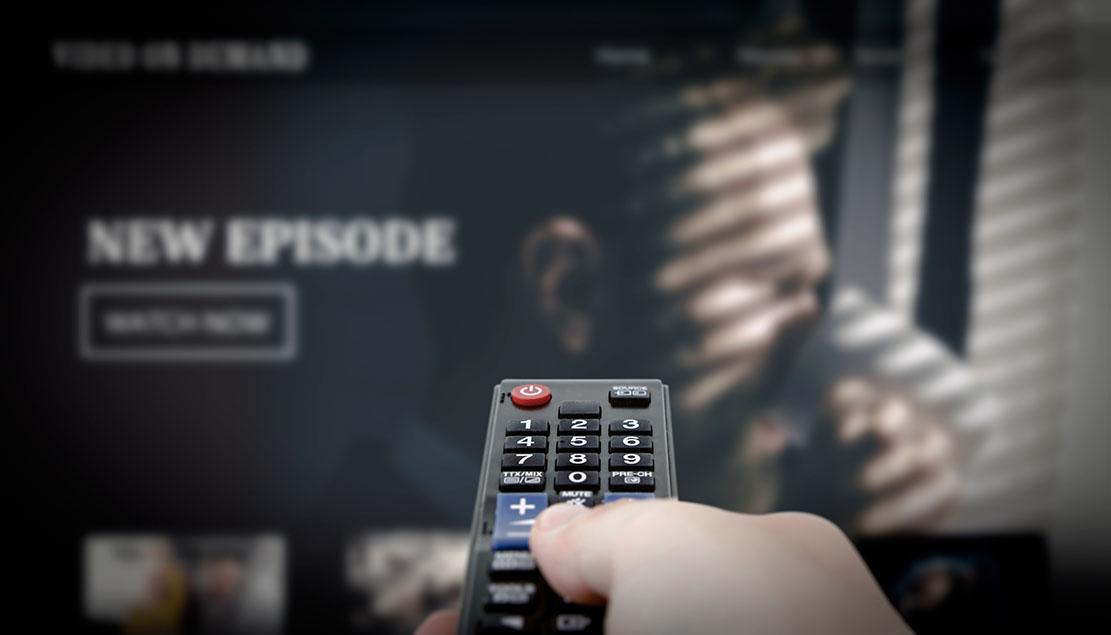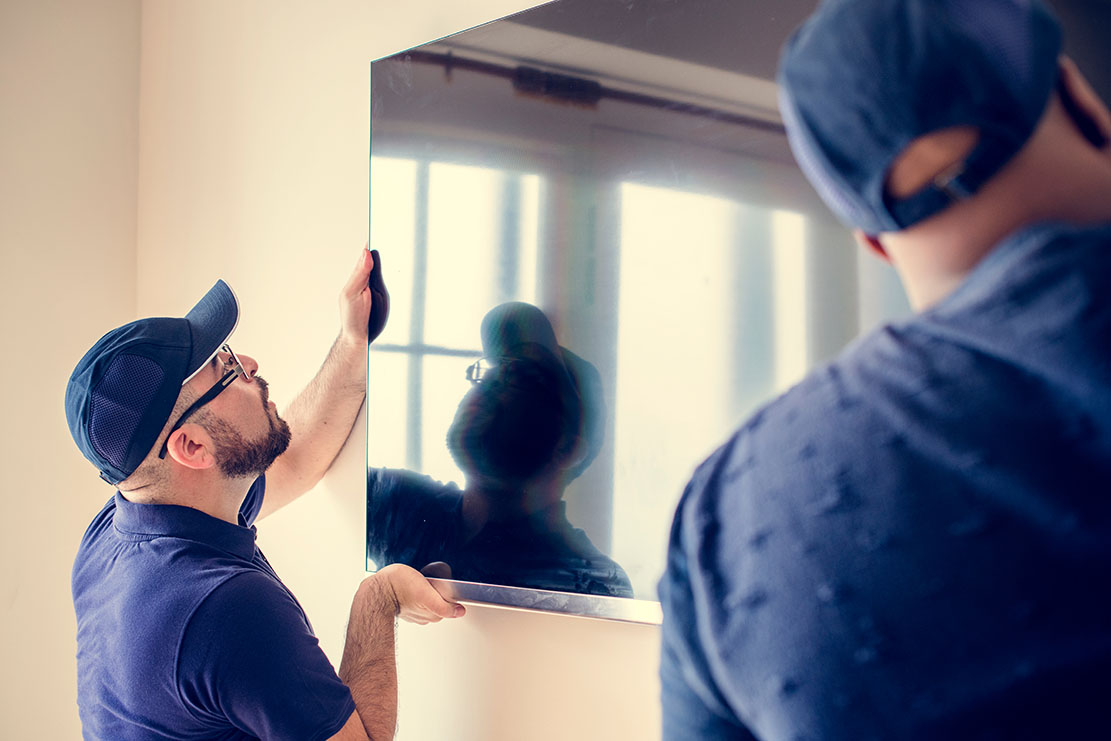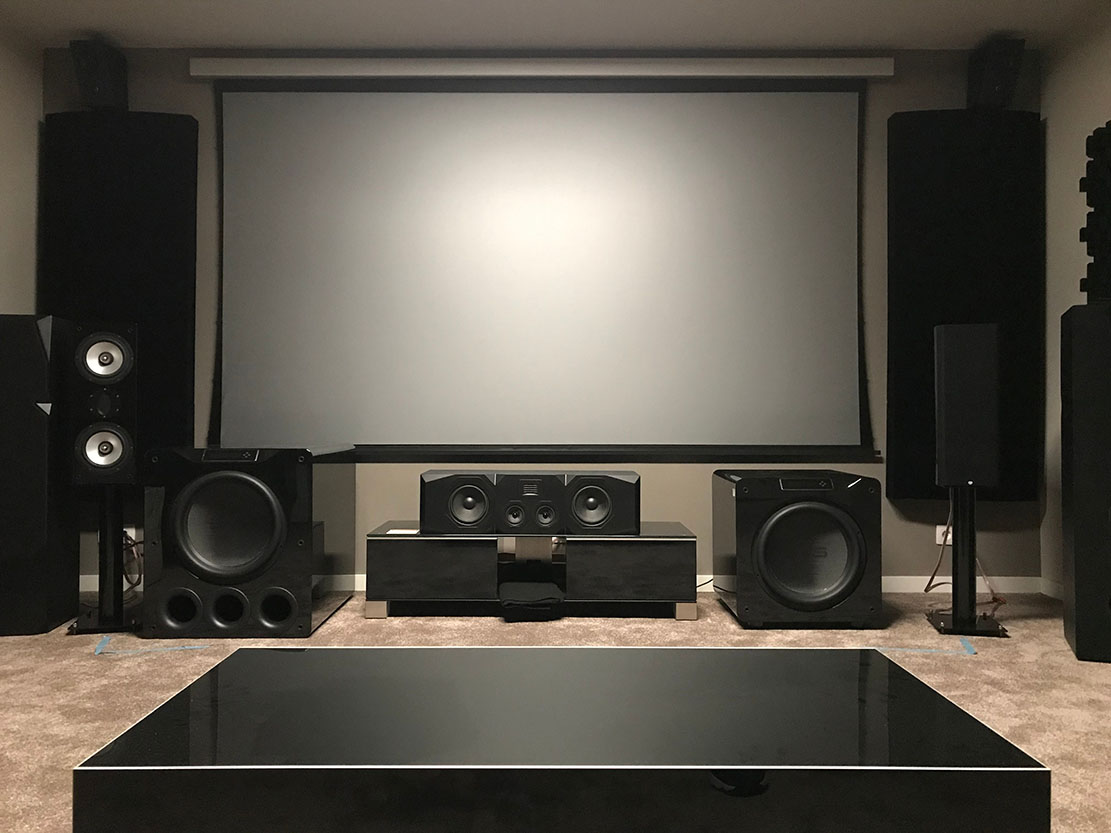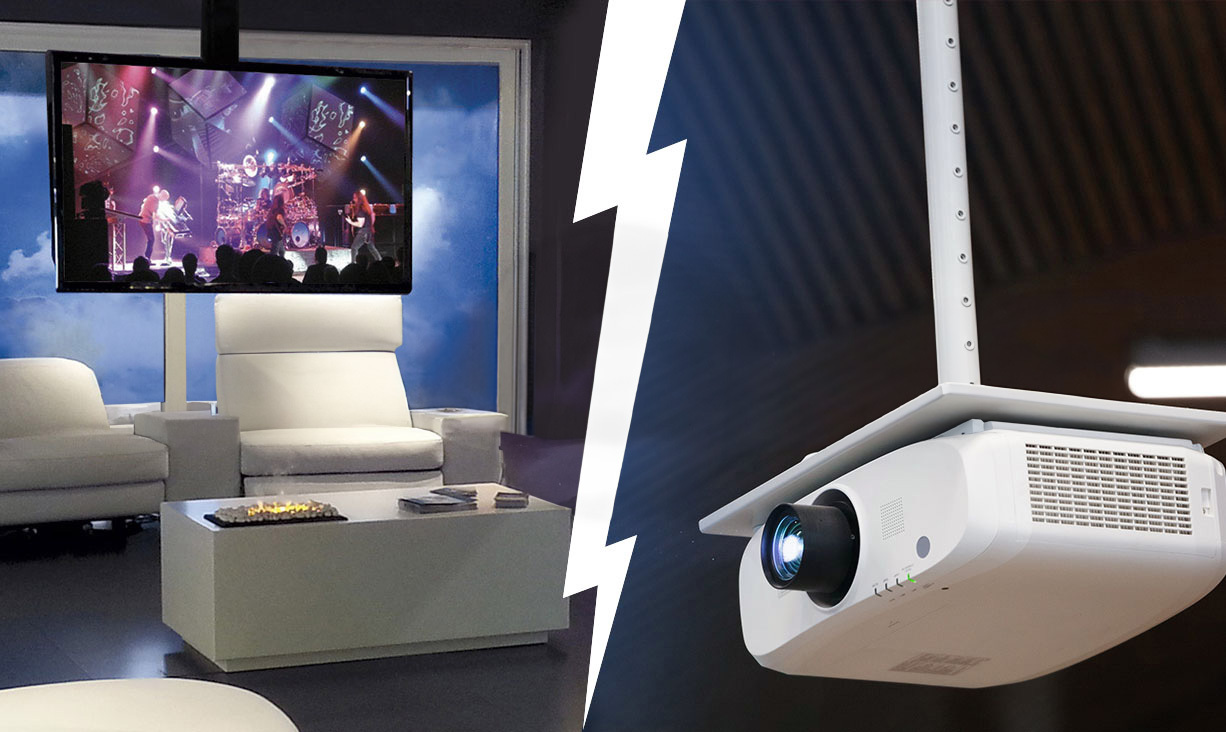Creating a home cinema that allows you to relive all the emotions of the big screen at home is the greatest aspiration of every film enthusiast.
A slightly outdated system to update, and the availability of adequate space, these are often the levers that lead to evaluations on the opportunity to create an environment completely dedicated to watching films, which can best enhance all the visual and sound characteristics.
At this point, one of the first evaluations to make concerns the system to which to entrust the video reproduction: better to orient yourself on a projector or on a large TV?
A projector allows for full visual immersion but can also involve major sacrifices, particularly in terms of image definition and audio quality.
The price is an element to be taken into consideration too. TVs now make it possible to obtain high-level images even starting from a limited budget, while to obtain high-level performance with a projector it is necessary to be ready for major investments.
An interesting alternative to the two hypotheses of above are the tv ceiling systems , which allow to get an experience closer to that of a screening room and make the most of the space in the house.
Large TVs and projectors: both solutions have advantages and disadvantages, and there are specific contexts where one solution is more appropriate than the other.
In this way, film lovers can relive every day the magic and atmosphere of the cinema in their own home .
Buying a TV is the best choice to enjoy a vibrant image in any light and low maintenance costs, but other factors also affect.
Let’s compare together the main features of large TVs and projectors by addressing these chapters:
- Size comparison
- Better brightness
- Perfect contrast and sharpness
- Comparison of high definition resolution
- Convenience and ease of installation
- Ideal sound system
- The most advantageous solution
- Better than a TV: a ceiling TV
Dream big: dimensions compared

When it comes to emotionally charged films and special effects, size can make a difference. A large enough screen means that enthusiasts can enjoy a real cinematic experience without leaving home.
Once upon a time the supremacy of the largest screen was undoubtedly up to projectors.
The evolution of technology has narrowed this gap considerably, making 85-inch TVs available on the market at affordable prices.
Projector screens start at around 100 inches in size , ensuring sufficient performance. A projector with acceptable lighting, good color reproduction, and even 4k resolution can cost a lot less than a high-end 4K UHD TV.
Bottom line: even though TVs are catching up distances, if the size of the image is one of the factors the most convenient choice is still the projector.
Best solution: a projector
The best brightness for a proper viewing experience


Forget 4K and HDR: the biggest problem of image quality with projectors is much more practical: ambient light.
Brightness is an element that undoubtedly affects against the projectors. The main problem of projectors is related to perceived contrast, which can vary considerably depending on the light inside the room.
A projector is not the only element inside a room to spread light on the screen: in fact, you will have to take into account every light element in the room, coming from external or internal sources.
The brighter parts of video images are not much affected by the overlap of other light sources, but the darker parts are conditioned by them.
The amount of light in a screen should be greater in less dark rooms. Environments with more natural light require brighter projectors, increasing costs for more powerful models.
For example, viewing sporting events or predominantly bright films may be acceptable. Watching a particularly dark horror film or science fiction or a video game with a dark atmosphere will be more difficult to follow and see.
While it is true that there are screens capable of rejecting natural light, we find ourselves unwillingly dealing with physics, at least on models that are not too expensive.
The projected light must be stronger than that of a TV screen: part of its power is dissipated by the cloth, since the light beam must bounce from the screen to our eyes. Most televisions are capable of producing sufficiently high brightness.
However, the degree of illumination of a TV is measured according to its brightness, that is, in Nit instead of Lumen.
A projector requires more energy to approach the brightness of a television, even if we compare it with a cheap model.
This requirement affects the performance and durability of the bulbs, which attenuate their intensity over time and end up burning, implying a costly replacement.
The problem has been overcome by laser projectors, although unfortunately they cannot offer a satisfactory degree of brightness or similar to that of a television.
Best solution: a television
Impeccable contrast: perfect definition in any environment


The contrast is determined by the ratio of the black levels of an image and its brightness. In a projector, we can evaluate the intensity of light by measuring it in lumens, while the black level is dictated by the darkness of the room.
An extremely bright environment can also affect the visibility of a TV screen, but a spectator can intervene by acting precisely on the contrast. Choosing a projector instead of a TV system precludes this possibility.
HDR – stands for High Dynamic Range – is a problem for projectors. Although many projectors are designed to accept HDR video, almost all eventually have problems with the correct display of this standard.
The problem is twofold. The first is that even the best domestic projectors are not that bright, at least compared to an average television. The second is that cheaper video projectors do not enjoy a good contrast ratio to best showcase the HDR format, as many models are unable to display a wide range of colors.
Even the best and brightest projectors can still only exploit a fraction of the brightness of a mid-range TV.
Brightness is not everything, but the contrast ratio has a big impact on the quality of big screen video: when it comes to HDR, the light output is much more intense.
Can the image of a projector be satisfactory without a flawless HDR? Undoubtedly, but it would not allow us to enjoy a complete visual experience.
Best solution: a television
High definition to enhance realism


The 4K technology of premium TVs is able to offer a range of colors and an impeccable image dynamism.
A television with this high resolution comes at a considerable cost, but its counterpart in the form of a 4K HDR projector has a price … astronomical!
For the same budget, it makes more sense to buy a good 4K HDR TV with a great sound system (or a Blu – Ray Ultra HD player) rather than a high – end 4k HDR projector high.
There are 4K HDR projectors that are not too expensive, but they can’t compete for performance with televisions of the same price range.
To the fanatics of “maximum possible resolution” , it should also be remembered that only TVs can currently have 8K resolution. If we consider a “pixel for price ratio” , the battle for the best resolution is won by televisions.
You don’t have to spend impossible amounts to buy a projector with good colors. DLP, 3-Chip LCD or LCOS models are all good compromises between quality and price.
Conversely, more technology is needed to get flawless colors from TVs, which justifies a higher price.
The best 4K TVs are capable of producing a wider color gamut than most projectors, but the difference is not that noticeable.
For those looking for a compromise between color quality and price, the most convenient choice is to buy a TV.
If budget is not an issue and we have a sufficiently large and dark room available, buying a high-end projector screen can give us the magic of a great image with flawless color.
Best solution: a television
Practicality and installation: two factors not to be overlooked


When compared, it is easy to see how televisions win the primacy of simplicity of use and installation compared to projectors.
Large televisions can appear fragile and heavy, but they are easy to install, configure and integrate into a home-theater system.
A TV also allows you to easily connect and manage other devices , controlling each function remotely with a controller only.
On the other hand, projectors are less immediate and require more effort in installation, especially in the case of projectors with short focal lenses.
The first problem to be dealing with a projector concerns the screen, which can be independent, motorized, fixed to the ceiling or to the wall.
Beyond the solution adopted, the screen of a projector requires the availability of adequate space.
The projector needs proper positioning or at a suitable distance, a more demanding challenge than we tend to imagine, which cannot be separated from the intervention of a professional.
The installation of a projector also includes the use of HDM cables I or wireless transmitters, which in turn affect the overall cost of the purchase.
Also, the connection with other devices should not be underestimated. New signal sources such as video games, smartboxes, Blu-Ray players or satellite decoders will require the use of AV receivers or HDMI switches.
Something in the field of projectors is moving, at least for laser models with Short Throw: You can simply place these models on a table or floor for good results.
The latest laser projectors have built-in soundbars and can be placed at less than 25 cm from the wall, partially simplifying its management. However, televisions remain the most practical and easiest choice to install.
Best solution: a television
The audio system that best suits your needs


As far as audio is concerned, a comparison between TVs and projectors sees televisions win : they are already equipped with speakers, very often more than satisfactory.
As already mentioned, some of the latest models of laser projectors already have soundbars, but – in addition to being limited in power and fidelity – they transmit audio from above or behind you.
Those who demand the most from the vision of a film on the big screen, cannot ignore the support of a worthy home-theater system, capable of reviving the cinematic experience within the walls of the house.
If external amplifiers, subwoofers and sound bars are sold separately, there is a reason. It is true that televisions are equipped with audio systems from the moment they are purchased, but their main function is to reproduce the best images.
Home-theater systems are born to obtain impeccable sound. both from televisions and projectors.
If we disregard this type of support, only high-end TVs can provide decent sound, once again making a TV more performing than a projector.
Best solution: a television
The best solution


The comparison of all the elements that we have considered clearly shows how the choice of a TV is more advantageous.
Watching a TV series, a sporting event or your favorite movie is not is compromised by the light in the room or any shadows on the screen.
A TV is a safe investment and in the long run, the picture always stays in perfect focus and you don’t need to worry replacement of worn components, such as a projector bulb.
Televisions can offer a infotainment advanced, with streaming capabilities integrated even in smart-TV models, with voice controls and a number of updatable applications still not fully supported by most projectors.
On the other hand, most projectors need to be connected to a TV or a computer to play television, as it lacks native software capable of interpreting the signals of an antenna or a network cable.
There is a growing demand of less bulky projectors, portable or easy to install. The technology is improving, but the installation process is still not simple enough or fast enough.
It is true that most modern projectors are equipped with moving lenses and zoom, while projectors with short focal lengths can be positioned a few centimeters from the screen. On the other hand, televisions remain more immediate in their use and are easier to install.
Why settle for a TV? Choose a Ceiling TV!
After comparing all the features and performance, it is clear that choosing a TV is more favorable than buying a projector.
However, there are still some points against the TV, such as the fact that its large black screen always visible strongly affects the aesthetics of the environment and requires a dedicated piece of furniture to support it.
Furthermore, installing a simple TV is a missed opportunity to give a more technological and avant-garde to the environment.
How to maintain the undeniable advantages of the TV, mitigating the disadvantages? A brilliant solution is to choose to install a TV on the ceiling, using a motorized TV bracket .
The TV ceiling mount allows you to completely hide the TV, minimizing the aesthetic impact once switched off, freeing us from the use of bulky supports, leaving amazed anyone that watches it open.
Choosing to install a TV on the ceiling means:
- investing in a space-saving solution;
- freeing the room from the clutter of a supporting piece of furniture; </ li >
- adjust the angle of the screen perfectly;
- choose to make the TV disappear into the ceiling.
Buying a ceiling TV with a motorized bracket means to make the most of every vision.



